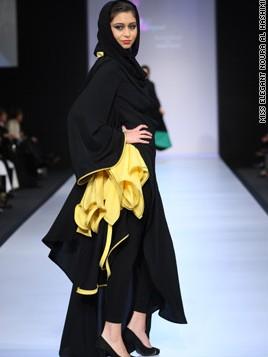 Just because a woman covers up it doesn't mean she can't show off her individual style. That is the belief of a growing number of fashion designers in the Middle East who are cutting conservative clothes with fashionable flair.
Just because a woman covers up it doesn't mean she can't show off her individual style. That is the belief of a growing number of fashion designers in the Middle East who are cutting conservative clothes with fashionable flair.
Traditionally the Islamic headscarf is a symbol of modesty, but today more and more Muslim women are dressing in eye-catching outfits, albeit with their heads covered.
"Modesty is not the opposite of fashion, and fashion is not about showing more of my body," said Amina al-Jassim, a Saudi designer who makes haute-couture abayas, the long-black cloaks typically worn by more conservative Muslim women, which are also mandatory in Saudi Arabia.
Just 10 years ago it was rare to see women wearing abayas with bright colorful accents and intricate embroidery walking on the streets of the Gulf. Today, they are a common site and their outfits are becoming more more elaborate and bold as the market for such clothing expands.
"What we are seeing now is a generation of local women who are aware of western fashion, educated overseas. They are seeing a lot more outside the smaller communities they live in," said Kerrie Simon, Editor of fashion magazine Grazia in Dubai.
According to Simon the influence of expats has generated a demand for clothing that allows women to express their unique personalities.
"We are seeing a move to accessorizing the abaya, anything from crystallizing to embroidery."
There is a "fine line," though said Simon, "They wouldn't belt them, or make them shorter, the idea is that the body is covered..
In other words the new popular new styles are not tighter fighting or more body accentuating, they respect the purpose of covering up.
"You can wear the colors of the season, the style of the season...you can get the traditions and principles right and still be fashionable," said al-Jassim. Along with many other designers in the region, al-Jassim also designs eveningwear and travel clothes that break Islamic dress code, but are still popular with local customers who spend time abroad.
Colorful trends, growing sales
Amina al Jassim is just one example of Islamic designers whose business has grown rapidly over the past few years. Today she has three stores in Saudi Arabia, sells her clothes at high-end boutiques across the Middle East, including Harvey Nichols and says she is making in-roads at Harrods in London. Al Jassim spoke to CNN from Lebanon where she had been flown to dress contestants on "The Gulf Star," an American Idol-like program on Dubai TV.
In Dubai up-and-coming designer Amber Feroz is helping set the pace of the new styles. In October he showcased his Spring/Summer 2010 collection at Dubai Fashion Week, which included diaphanously flowing abayas with electric-colored trim.
"We have a very different way of working with the fabric...We came up with new techniques -- there is no seam. Our fabric is very lightweight. We use a lot of colors" Feroz told CNN. In his latest collection for the Miss Elegant Noura al Hashimi line, Feroz said he combined the concepts of jalabyas and traditional kimonos.
"We are expanding as a brand to sell all over Gulf," he said, adding that the company also had their eye on moving into European and Asian markets.
In Egypt, where fewer women wear the abaya, but an increasing number are wearing the traditional hijab head coverings, Wegdan Hamza has become something of a national style star. Not only does she outfit local celebrities with her hijabs, but she appears on programs like Dream TV's "The Latest Fashion" to discuss current trends.
"God makes us beautiful and he likes the beauty, so we have to mix and match our outfit correctly, in colors materials and style," Hamza told CNN. "It is illogical for everyone to look the same."
"Not to see through or describe the body -- those are the rules. After that I have the freedom to put on whatever I want," she added.
Hamza's collection of hijabs include everything from the casual and cotton, to trendy -- embellished with flowers or coins, to bridal -- topped with crowns. Currently she says she's feeling the recession pinch, but business has been steadily growing for several years, particularly her online sales to Europe and North America.
Of the designers interviewed only Hamza acknowledged some cultural pressure or criticism to design less showy clothes, but said that she dismisses it completely. The other said women were waiting for their clothing.
When asked about it, Grazia Editor Simon said, "It's not so much a conflict, but an amalgamation of east and west that works quite nicely here."





